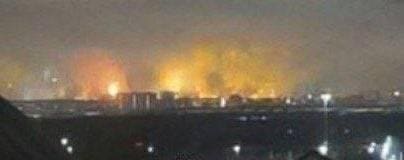Kazan is burning.
Via Strategic Communication Center
On January 8, Ukrainian drones flew at least 600 kilometers to strike a large fuel storage facility near the Russian Air Force’s Engels bomber base in Saratov, southern Russia. Six days later, drones strike same fuel depot Againfueling a fire that continued to burn days later.
Today, Ukrainian long-range unmanned aerial vehicles are attacking the factory that builds and maintains many of the Russian Air Force’s bombers: the Kazan Aircraft Plant in Kazan, about 700 miles from the front line in Ukraine. On Sunday night, Russian Telegram users reported drones overhead, as well as an explosion and fire at a fuel depot near the plant.
“Illuminating the night sky of Russia’s Kazan region, burning Russian aircraft manufacturing facilities for the production and repair of long-range strategic bombers that regularly rain missiles on the Ukrainian people,” celebrated the Ukrainian Center for strategic communication as flames rose and smoke rose in Kazan.
Sunday night’s strike was only part of a larger wave of raids. At the same time as Kazan exploded, Ukrainian munitions – drones or missiles – hit a helicopter factory in the city as well as a fuel depot in the Bryansk oblast in southern Russia, just 40 kilometers from Ukraine. “And there will be more,” promised the Strategic Communications Center.
It is unclear what types of drones were involved in the attacks on Kazan. Ukraine has developed a dizzying array of long-range drones, some of which are based on modified A-22 sports planes. Saratov’s initial raids may have involved the smaller PD-2, Beaver, Liutyi and UJ-22, all between six and 10 feet long, propeller-powered, presumably GPS-guided and capable of flying hundreds of miles with explosive payloads. .
It is noteworthy that many of the recent deep strikes carried out in Ukraine have targeted fuel depots. These raids are in some ways a corollary of the ongoing campaign of strikes targeting the Russian oil industry, particularly its refineries. Oil not only fuels the Russian war machine, it is also a major source of revenue for the Russian state.
Exploding fuel tanks attached to Russian bomber bases – and industrial sites associated with bomber bases – probably cannot stop the Russian bombing of Ukrainian cities, but it can make the bombing more costly for Moscow.
And blowing up fuel tanks and factories is easier than blowing up the bombers themselves. The bombers – 120 Tupolev Tu-22Ms, Tu-95s and Tu-160s – fly high and fast, launch their cruise missiles hundreds of kilometers from Ukrainian cities and, when on the ground, are spread across potentially dozens basics.
In contrast, tanks and factories are large and immobile. Easy targets for Ukrainian drones.


